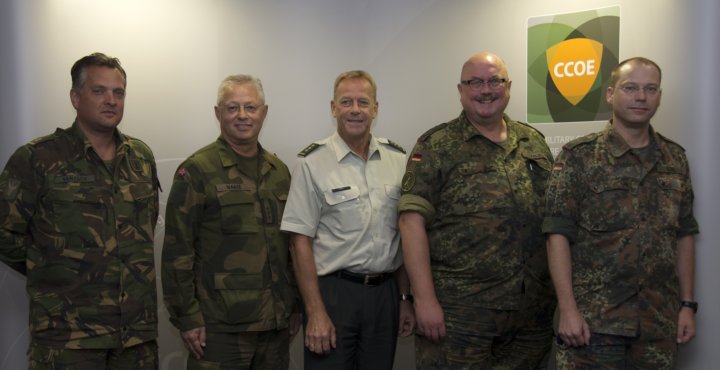CIMIC Commanders Round Table
(Left to right: LTC J. van Esch (Commander CMI Command), COL K. Waage (ACOS G9 1GNC), COL R. Been (DIR CCOE), COL W.F. Paulik (Commander ZMZBw), LTC A. Eckel (DDIR CCOE))
At the 18th and 19th August 2015 the leaders and branch heads of 4 Headquarters met at the CCOE in The Hague. The intent was to exchange information, foster cooperation and create synergies to facilitate the progress in the field of Civil-Military Cooperation and Interaction.
The 4 Headquarters are: “1 German/Netherlands Corps” (1GNC – Muenster/GER) – G9 Branch for Civil–Military Cooperation, the “1 Civil-Military Interaction Command” (1 CMI Command – Apeldoorn/NLD), the “Zentrum Zivil-Militaerische Zusammenarbeit der Bundeswehr” (DEU ZMZ – Nienburg/GER) and the “CIMIC Centre of Excellence” (CCOE – The Hague/NLD).
Apart from the fact that all these entities deal with CIMIC and are highly committed to contribute to a Comprehensive Approach all these entities are either Dutch or German or have both nations as framework nations.
The leaders and branch chiefs were also interviewed. You can see their statements regarding the Framework Nations Concept, CIMIC within the NATO Response Force/ NATO Art V. and their forecast regarding CIMIC future in this article.
Lieutenant Colonel Joris van Esch, Commander NLD CMI Command, NLD-Army
Q: How much does the multi-nationality of CIMIC in NATO depend on the Dutch-German integration?
Both Germany and the Netherlands are actually pooling at CIMIC. They are the two main contributors to the CCOE and by that they demonstrate that CIMIC has an important part in modern operations. By creating the CCOE as a hub of knowledge, as a training center, they are on the forefront of CIMIC developments into NATO. And as CIMIC is a multinational business, you learn here what to do in operations.
Q: Where do you see the future of CIMIC in general – separate from specific scenarios and missions?
We have learned in the last twenty years that CIMIC is an essential part of each operation. It is not just linked to stability operations but also to Article 5 operations. In each operation you will see that there is at least a third or a fourth party, and that each operation will take place in the civilian environment. Whether you want it or not, whether you like it or not, each operation will have a civilian component in it. And you need CIMIC capacities, CIMIC trained people at the CCOE, to deal with that. To prevent harm from the civil environment to liaise with the civil environment and that is what CIMIC is all about. So in all modern operations you will see CIMIC people active.
Colonel Wolfgang Friedrich Paulik, Commander DEU ZMZ, DEU-Army
Q: Which advantages do you see in the Framework Nation Concept and where is the role of the CCOE in this?
The Framework Nation Concept (FNC) is a NATO Concept, based on a German initiative within the context of Smart Defence. The benefit of this Concept is that it gives nations the opportunity for training, education, participation in operations and contribution in concepts development in cases that their capabilities, in our case CIMIC, are not large enough to do it by themselves in a cost effective way. The role of CCOE within the FNC is a contributing one, as the FNC is focusing on nations, which are offering to be the framework and other nations and entities, which are contributing. In this role the CCOE could take over an important role within the FNC.
Q: Where do you see the future of CIMIC in general – separate from specific scenarios and missions?
CIMIC is an integral part of every operation and each level and in every intensity, and like all other military branches and capabilities, we have to be prepared for all different types of mission. So, next to ongoing missions, we have to be prepared for any kind of missions. And this is how we prepare. To make it very clear: To link CIMIC only to Stability Operations would be the wrong perception. We have a role to play also in Article 5 Ops.
Colonel Kato Waage, ACOS J9 1.GE/NL Corps, NOR-Army
Q: When looking at CIMIC in the NATO Response Force (NRF) and in missions, where do you see the most recent developments and key experiences or learnings?
We are in the NRF operating as the land component commander. This means that we will operate within a civilian environment and this means also that we need learn how to operate in this environment. We need to understand those perspectives and also need to de-conflict in whichever disagreements exist, while trying to agree on certain goals and objectives in order to achieve a common understanding and purpose in how we operate.
We have looked closely into the framework in which we work with civilians. We started a couple of years ago with a separate approach, normally asking the civil community to participate in our exercises. What we are doing now with such exercises is to find a common effort and to reverse the logic. So, once a year we trying to design an exercise setting where we together with the civilian perspective at some problem settings, jointly developing our assignments and thus developing the exercise. Then we meet to look how we can work together and where we have commonalities and disagreements. Basically, this is approach is used in order to learn to how to work together and to understand and respect each other’s perspectives.
We are trying to establish a working structure with the civilians which enable us to work with those partners in whichever situation we are in. It has helped us a lot to work with the civilian partners. For me, responsible for CIMIC at the Corps in Muenster, it has been the core task to re-address our concepts, the way we operate liaisons, the way we operate planners and the way we look at problem sets, how to interact and how to improve the process procedures. Overall, it has been very helpful for us to operate as a Corps on tactical, component or event joint level in a more complex environment.
Q: Where do you see the future of CIMIC in general – separate and independent from specific scenarios and missions?
I try to simplify things when we talk about CIMIC. The military force is never alone, and we have not been very good at explaining why CIMIC is important, and how it can fit into the way we operate. In my opinion, we have the military operation and the context; some call the context the civil environment. But you also need somebody competent in the military staff, someone who is able to bridge the gap, meaning that you are able to communicate to the civil environment your perspectives, but also bringing the civilian environment perspectives into our planning and operations.
So, this bridging function is very crucial and will work independently of the type of operations. Weather we are active in our NATO function, or as part of a stability operation in Africa is the same in principle. There are just some mechanics in the way we operate that will change, and the perspective will change, bit this is the core of our business. We try to improve CIMIC all the time so it can be that bridging function between the military unit and the civil environment.
COLONEL Roel Been, Director CCOE, NLD Army
Q: Where do you see the advantages and mutual benefits of these four CIMIC entities located so closely together?
It is good that the commanders are here together at the CCOE, because we are working closely together. We are from Framework Nations, the Netherlands and Germany; and we have the German Netherlands Corps (GNC) in Munster and the CCOE in The Hague. The GNC has an annual CIMIC event “Common Effort” that we want to support and as a preferred network campus on CMI we need to be a part of this community as well. It is great to have all these commanders around the table, it would be great to do this once in six months.
Q: Where do you see the future of CIMIC in general – separate from specific scenarios and missions?
Whatever scenario or mission we are in as the military, we will never be the only party. It will differ from each scenario, but there will always be non-governmental organizations present, there will be governmental organizations and together we have a job to do there. It does not matter if it is a crisis response operation, or a defense operation, or a humanitarian relief operation, there will always be more parties involved than only the military. There is never an exclusive military answer to the current challenges that we are facing in NATO and around NATO.
Find out more about the CIMIC Headquarters and units on:
www.cimic-coe.org (CCOE)
http://1gnc.org/ (1 GNC)
https://www.facebook.com/1CMICo (CMI Command on Facebook)

